After Jerusalem, Seoul is definitely one of my favorite cities in the world. As my friend Ben said, it has everything a city could possibly want: the hip and modern with its lively night scene and the busy metropolitan sky-towers, but also the quiet and cosy with its historical villages, tucked-away quaint cafes, and the long stretches of park beside river.
I spent 10 days of adventure and exploration in this beautiful city and so for anyone who is interested in spending a few days, here is a quick run-down of the districts and my favourite spots.
The North: History in the Bukchon Village and the People’s Square
Seoul is divided by the Hangang River, with the north of the river being “old money” and historical, while the south being modern, yuppie and bourgeoisie. Being the romantic I am, my ideal day would be finding a hipster cafe or vintage teahouse to hole up in and just write, of course, accompanied with a layered matcha-cream cake.
One of the districts a visit to Seoul must include is the bukchon hanok village. The bukchon village was formed during the early Joseon Dynasty (1392 – 1910) and originally housed noble families and high-ranking officials. Now, the villages are mostly residential areas, but also an endearing cultural relic for you to wander and find tucked-away gems among the traditional Korean-style hanoks.
Hanok Stay
To get an authentic homestay experience, I would recommend a hanok stay with a Korean family. So does CNN travel with its top 5 reasons why you should stay at hanok while in Seoul. I stayed at Yoo’s guesthouse for 3 nights, where I was housed in the Room of Hope. The decor was simple with its latticed sliding doors, wooden panelled floors and basic furnishings. But, I felt like I got a taste of traditional Korean living, sleeping on the floor with a thin mattress and waking up to Mr. Yoo calling me to the kitchen for a traditional Korean breakfast. I had chook (porridge) with a dash of soy sauce paired with cheon (Korean battered pancakes) and salted anchovies the first day and bulgogi bibimbap (soy sauce beef rice bowl) the second. The guesthouse was well-equipped and the couple friendly. They provided me with a hairdryer, adapter and a water heater (which supplied me my Korean instant coffee in the mornings), along with maps of the locality and recommendations of tourist spots.
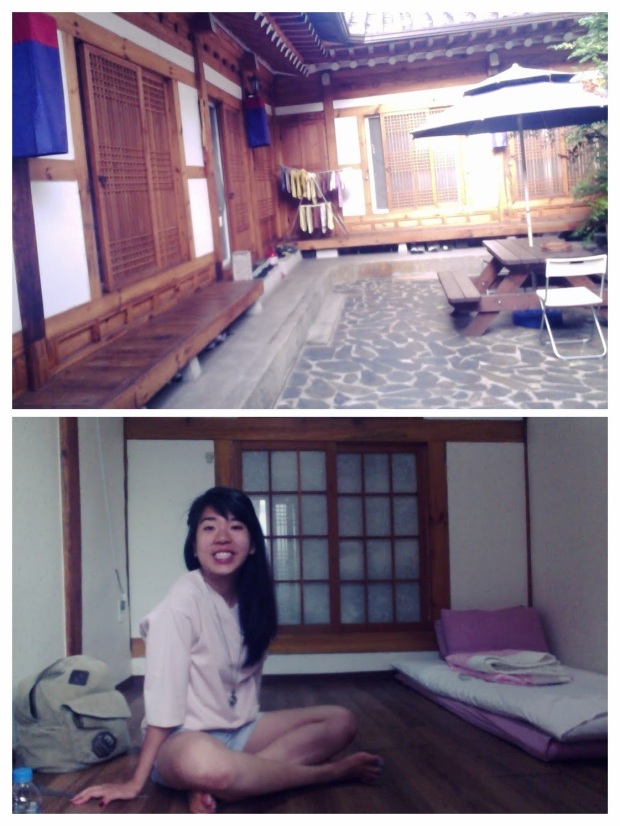
Exploring the Village
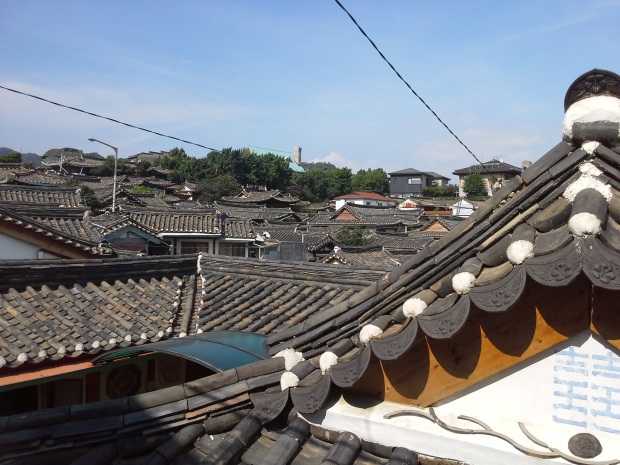
My first day at the guesthouse, I ventured out to the nearby village (about a 10 min walk from Yoo’s), armed with a map from the Bukchon Tourist Information Center. The map is a good guideline, but the best parts are off the beaten path, away from the swarms of tourists. These are some of the hidden gems I found on my wanderings:
Cha Masineun Tteul
On the top of the hanok village mountain with an incredible view of the rooftops nestled among treetops is a quaint teahouse, serving steeped ginseng or jujube teas accompanied with sunflower seeds and chewy puffed rice snacks. I ordered an oriental raisin tree tea and enjoyed steeping the leaves repeatedly as I sat cross-legged at a low wooden Korean table. The soft music and cool air under wooden slanted roofs made it a peaceful oasis from the blistering heat.
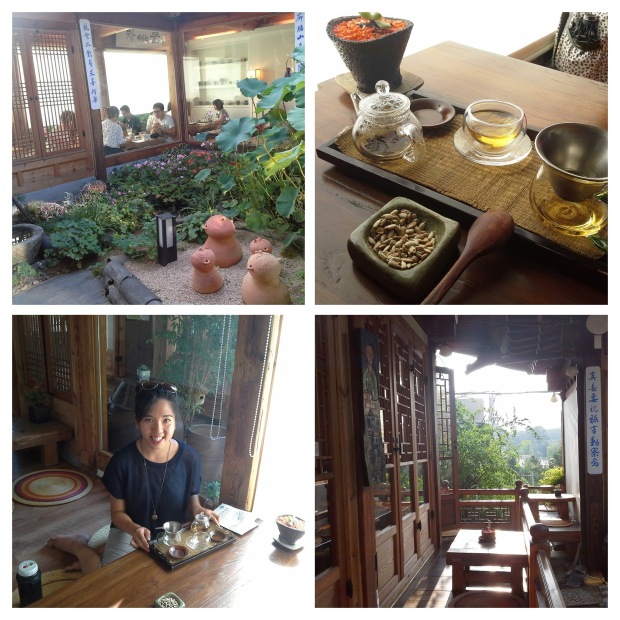
Granhand Scent Shop
Walking up the picturesque Bukchon-ro 11-gil, I chanced upon a scent shop run by a petite young girl dressed in a homemaker’s apron. She kindly introduced me to the homemade scents in the form of candles, laundry sprays and diffusers. I bought an “Esther Dean” laundry spray, which had hints of pear and cedar.
Jiyugaoka
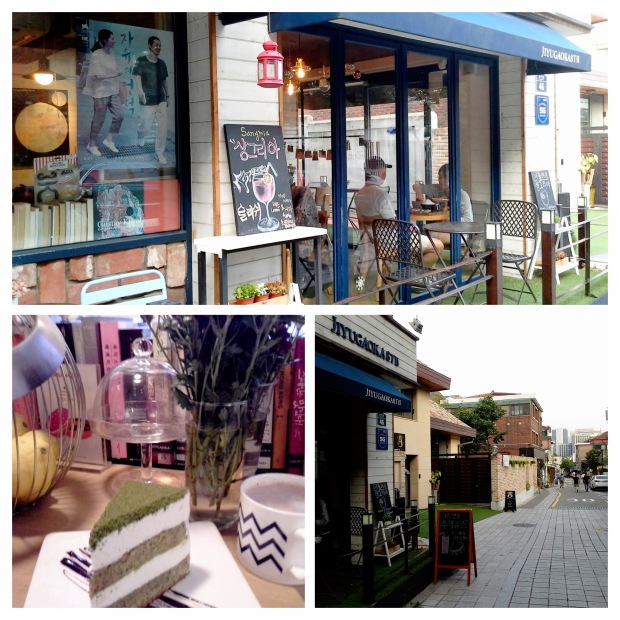
I am always on the look-out for cool cafes. Recommended by the infamous Lady Iron Chef, I decided to head on down. Located at Yunposun-gil 46, it is the perfect cosy spot for some people watching, and travel-blogging while digging into a matcha cake and sipping a chocolate latte.
People’s Square and Chongyecheon Stream
The north-west of the city is where the present government resides – in the Blue House next to the historical palaces. To explore this area, I took a subway to Jonggak (line #1) which would land you in the older area of Jung-no gu. My friends took me to eat Andong jjimdalk (Korean-style braised chicken) before walking west to the People’s Square via the Chongyecheon Stream. Along the stream, children play in the water, sunlight streaming in and bouncing iridescent off its surface as fathers perch with cameras hung around their necks, shutter-happy.
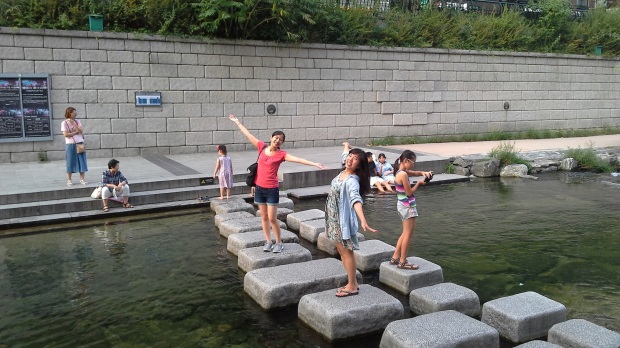

The People’s Square is a long stretch of wide sidewalk where festivals or politically-charged protests are held. When we were there, a protest in the form of a street festival fighting for the justice of the victims of the Sewol ferry disaster was taking place. The statue of Sejong the Great, the founder of hangeul, stands erect and peaceful in the middle of the square.
At the end of the long stretch lie the palaces and if you were to head north-west, you would hit Buamdong – a rich residential area that used to house the nobility of Seoul. It is now a quaint and quiet neighborhood with cafes scattered among its hilly terrain. We stumbled upon one called “Lumberjack” where we slurped up icy grapefruit ade.
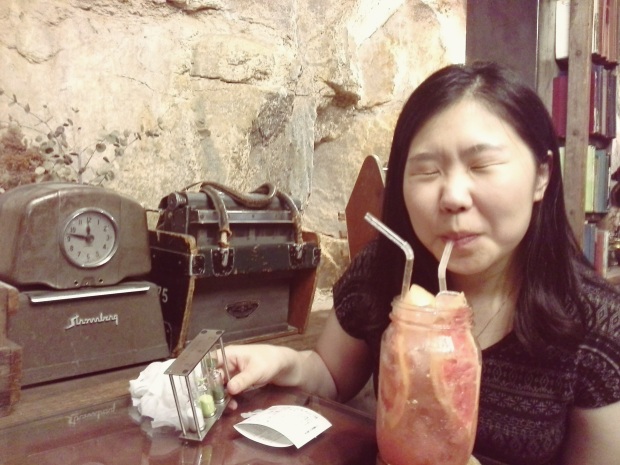
Korean Princess for a Day: The Gyeungbokgung Palace and Tosokchon
The best friends are the ones who are willing to do anything with you – including prancing around Seoul in traditional Korean costume. The day after Ben arrived, we decided to be the royal family for the day – a decision not only rewarded with free admission to all the palaces, but also the stares of many curious onlookers as they evaluated this anachronistic scene.
There are many hanbok rental places in Seoul, but we chose one in Chungmoro called “Oneday Hanbok”. For 13,000 won, we rented full outfits (mine came with a pretty headband, handbag and hair accessories) for 4 hours. I think the hanbok is the prettiest traditional outfit of all, so I had the time of my life posing with the palace architecture in the layers of chiffon and silk.
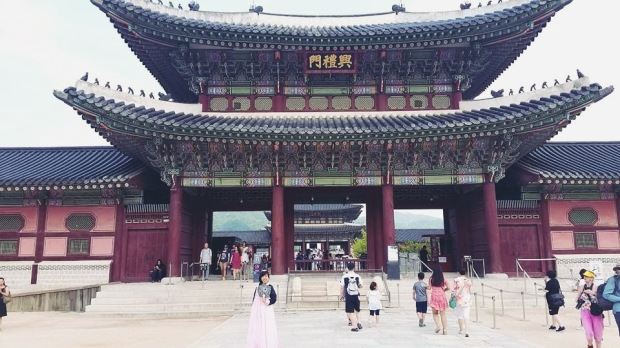
The palaces can be quite crowded with Chinese tourist groups, but the palace is big enough for you to find untouched spots where you can be alone and get a good picture. I would recommend grabbing a guide at the welcome center instead of going for the free tours as it allows you the freedom to wander around yourself.
 I would, however, hit the Seoul Folk Museum in the middle of the palace grounds, where there are four exhibitions that give a good overview of Korean history and culture. Admission is free and the air-conditioning is a welcome respite from the heat (especially when you are buried under layers of hanbok).
I would, however, hit the Seoul Folk Museum in the middle of the palace grounds, where there are four exhibitions that give a good overview of Korean history and culture. Admission is free and the air-conditioning is a welcome respite from the heat (especially when you are buried under layers of hanbok).
A trip to the palace would not be complete without a visit to the famous Tosokchon (featured left), where stuffed ginseng chicken is served on demand. The line may be long when you arrive, but you are soon ushered into the oldest established ginseng chicken restaurant. Recommended by many travel blogs, Tosokchon did not disappoint. It even out-surpassed our expectations when we found dates and chestnuts nestled in the glutinous rice our chickens were stuffed with.
Shopping Joy: Insadong, Namdaemun, Dongdaemun and Myeongdong
Each shopping district in Seoul has its own character.
Insadong
Insadong, being close to the bukchon hanok village and the palaces, is more traditional, selling trinkets and souvenirs. I visited the area three times in my ten days. Places to hit would be:
Ssamziegil

An interesting mall with a zig-zag ramp that traverses the mall, giving you a good look into each boutique shop. On the first floor is a booth selling bbomg dang (directly translated as “poop bread”) stuffed with either red bean or chocolate. I bought a set where it came with iced hyesik (Korean sweet rice drink). My friends and I also dressed up in hanbok and took booth-photos (yes, the cheesy ones you can decorate)
Traditional tea house
I went to two during my stay. The first was called “Dawon” in the Kyung-in Museum of Fine Art. The minute you walk in, you can smell the richness of the jujube tea. Our order of date tea, ginger tea, medicinal herb tea and cold matcha milk came with the puffed rice snack and calmed our senses as we inhaled and sipped simultaneously. The second was one that Ben looked up called Sinyetsenchatjip. It had a cosy, vintage feel with collectibles, presumably from the owner’s travels or an auction for antiques, lining the walls. I ordered a papaya tea – a sweet thick tea with pieces of dried papaya – while Ben got a traditional chrysanthenum.
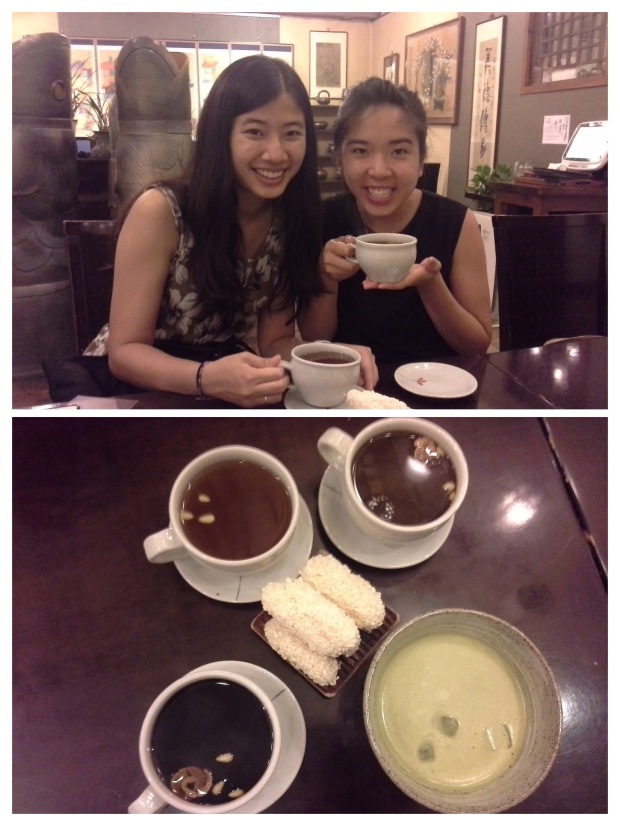
Tobang
When I was hanging with Esther, we were looking for a place to try her much-loved mukbap (acorn jelly cold soup) and on a whim, ducked into Tobang (50-1, Insadong-gil). Much to our surprise, they served us amazing side dishes – marinated crab, anchovies, excellent kim chi – along with our order of mukbap and seafood pancake, all for a very reasonable price.
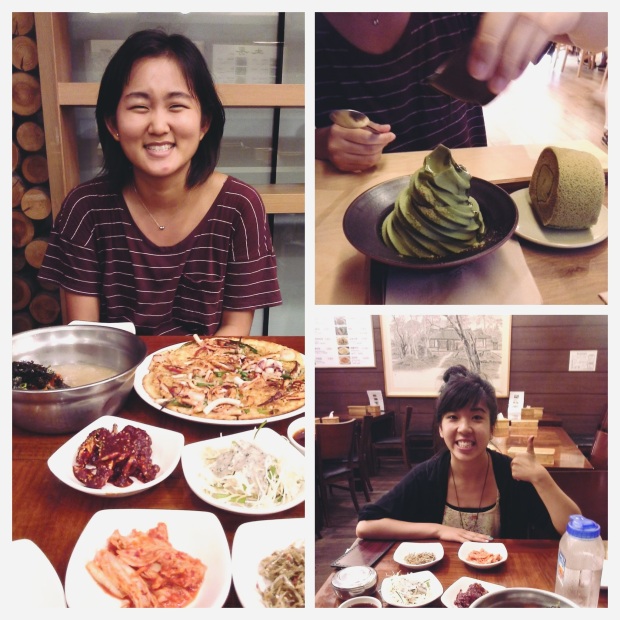
O’sulloc Tea House
This is a chain green tea dessert store with branches all over Seoul, but I had to try the one in Insadong. The store front has paper cups for you to taste the tea from Jeju Island, but Esther and I made a bee-line to the counter inside, where we ordered green tea ice cream with matcha drizzle as well as a green tea sponge cake roll. For a matcha fan like me, it was a hit.
Namdaemun
Namdaemun Market has more of a night-market feel, where stalls are nestled close to each other, selling cheap, wholesale clothes of sketchy quality and street food like hotteok (a sweet cinnamon sticky pancake that I tried – thumbs up!). We got a map at the information center, and had fun meandering along the narrow streets lined with stalls, inspecting but being careful not to buy any wares.
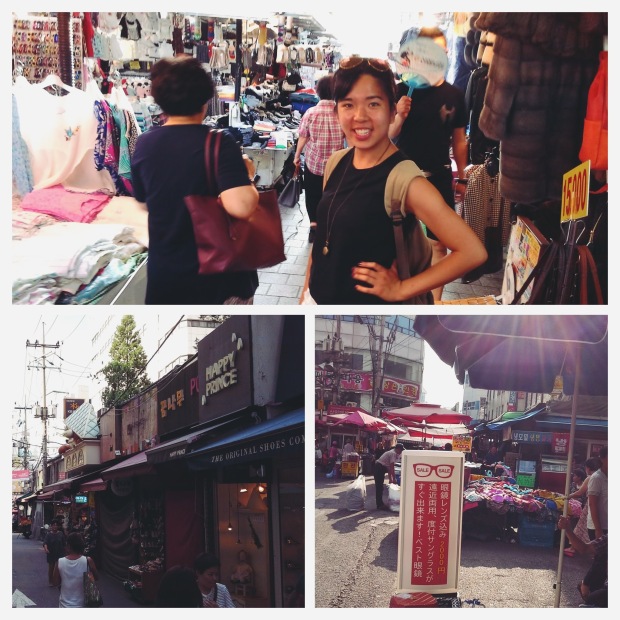
Dongdaemun
Dongdaemun Market would then be the opposite of Namdaemun. Upscale and trendy, Dongdaemun is a collection of air-conditioned, multi-level malls where clothes sell for 30,000 won and up. I perused some of the styles at Doota (a mall that Erin Kim recommended), but after realizing that my finances did not entitle me to shop here, we promptly left. Later, Lydia told me that there are cheaper places in Dongdaemun.
Myeongdong
Myeongdong is the cosmetic center of Korea, housing a branch (or three) of every Korean cosmetic brand you could think of: Innisfree, EtudeHouse, Missha, Nature Republic. The best part is that you can sample, and by the end of my trip through the district, my face was covered with all sorts of creams and my nails each painted a different color. They also give you free samples with each purchase you make – not a bad deal for quality avocado masks from Nature Republic and mint green nail polish from Innisfree.
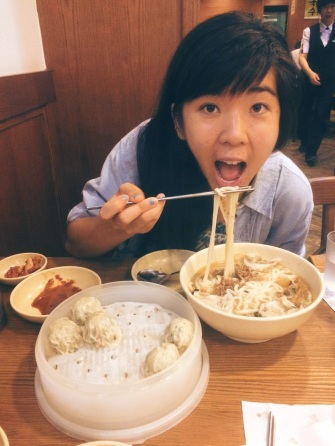
While you’re there, have lunch at Myeongdong Kyoja – a famous restaurant with one thing on their menu: soup noodles with ground beef and dumplings (featured left). If you’re feeling adventurous, try a cat cafe. We went to one called “Cat’s Playground” and were surprised with how clean it was. It is definitely a different experience having cats pounce on your table as you drink your cinnamon chocolate mocha. At night, Myeongdong comes alive with street stalls. I would particularly recommend the tteok-galbi meatballs, but the desserts such as the famous carp stuffed with ice cream and honeycomb or the egg bun with almond and sunflower seeds are worth trying as well.
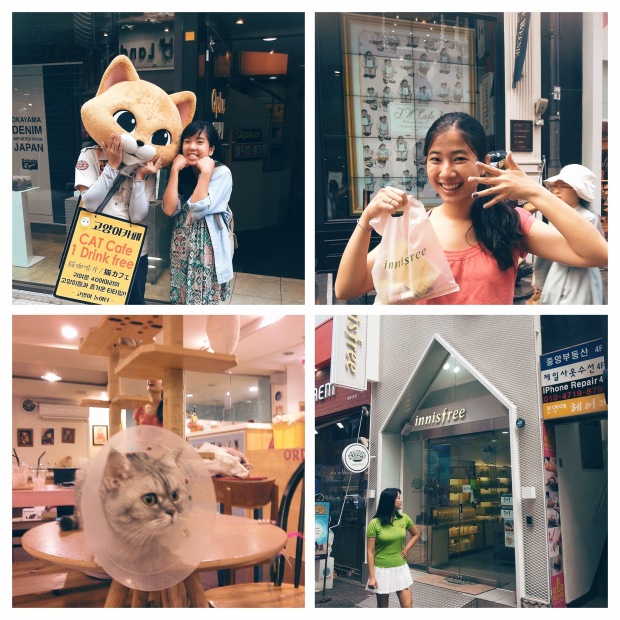
Where the Youngsters Hang: The Party and Shopping scene
Gangnam
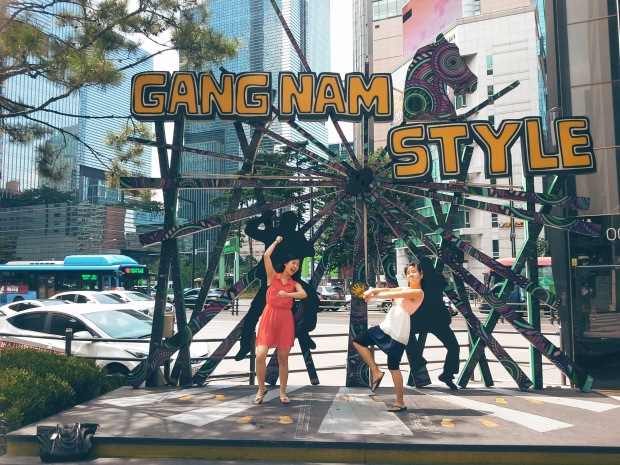
I’m sure you’ve heard the song “Gangnam Style” by Psi that blew up the radio and the dance floors all over the world in 2012. So, there is actually a stage in Gangnam where you can press a button and dance to the song. Who could resist doing that horse trot and side lasso on the stage? It is an area known as bougeouise, pretentious and rich. I quickly caught on as advertisements for plastic surgeries yelled at me the moment I exited the subway station and the two places we went to eat at (Better than Beef and an art cafe called Dori) sold expensive fare. Still, I thoroughly enjoyed catching up with university friends over pork belly in a spicy tomato based sweet sauce for dinner and blueberry pie with a flaky crust and rich center at the cafe resembling a cute doll house. I was reminded of the privilege that comes with the Princeton life, as we conversed on summers in Nairobi, North Korean defectors in Mongolia and the possible imminence of WW3.
Hongdae
Hongdae is where Hongik University is located, a hotspot for street performers, Korean BBQ and party culture. I found an awesome backpacker’s hostel called Crossroads that let you stay in a comfortable 8-bunk bed room for 10USD per night. Not only did I get to meet travellers from different cultures, but I got my private bed complete with a curtain and clean sheets. The area was replete with cute cafes, one called Cafe Ann where they had private booths overlooking the Hongdae area. The dessert was exquisite: a thick slice of caramel honey bread topped with a scoop of vanilla ice cream and a sprinkling of cranberries plus a fondant chocolat.
Ehwa
Another university central spot is Ehwa. Young people come here to shop cheap clothes, shoes and jewellery. I did the majority of my shopping here, picking up cheap walking strappy sandals and some long vintage necklaces. Other than Ehwa, you can also pick up cheap and fashionable clothes at the underground malls, the largest one being the Express Bus Terminal Underground Mall. I found a super cute sweetheart neck dark blue dress for only 3,000 won (less than 3 USD)! Talk about bargain shopping.
Political Tensions Rise: Visiting North Korea
There are many tours available to bring you to the De-militarized Zone (DMZ) between North and South Korea. With the recent rising tension given North Korea’s belligerent nuclear missile testing, I believe it’s increasingly important to understand the current situation. My friends and I decided to go for the combined full-day tour, which included the Dora Station, the Observatory from which you could see North Korea, the 3rd Tunnel and Imjidak in the morning. After a bulgogi lunch, we ventured into the danger zone – Camp Bonifas and a tour of the Joint Security Area. While the morning consisted of areas that could be visited by the general public, the afternoon was the most interesting and high-security.
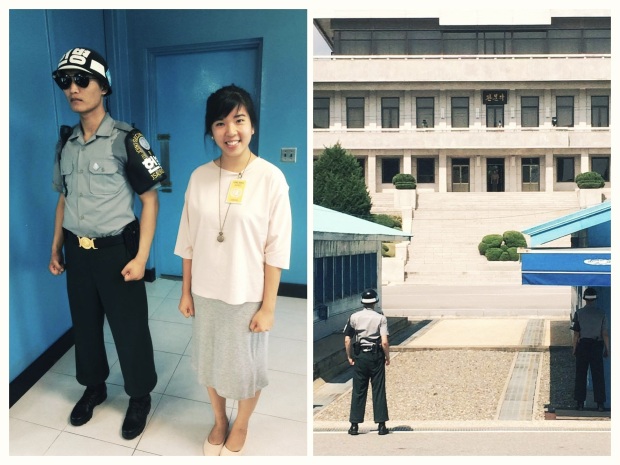
The highlight of the tour was probably when we were lined in two rows at the border between North and South Korea. The silence was almost tangible as sweat beaded on the foreheads of the guards that stood facing a country closed off from the world. It was hard to believe that in a modern society like ours, there still exists such a border of hate and unease. I took a picture (above, left) with the guard who protected the door leading to North Korea, but accidentally took a step behind him. His head swivelled sharply before snapping back into place after ensuring that I wasn’t about to defect to NK anytime soon. I apologized repeatedly, bowing my head to him in humble deference.
I visited the DMZ a second time – this time on a prayer tour for the peace between the two Koreas. As I stood atop the Ohdu-San Observatory that overlooked North Korea, I recited the Lord’s Prayer over this country wrought with poverty and suffering: let your will be done on earth as it is in heaven…
Popular Korean Leisure: kicking it back in the jjimbang
One of my favorite experiences in Seoul was chilling in the jjimbang (Korean spa), a popular hangout spot for the locals to de-stress after a long day of work. The most extensive jjimbang is Dragonhill Spa and Resort and so, Hyewon and I venture out to Yongsan for our adventure.
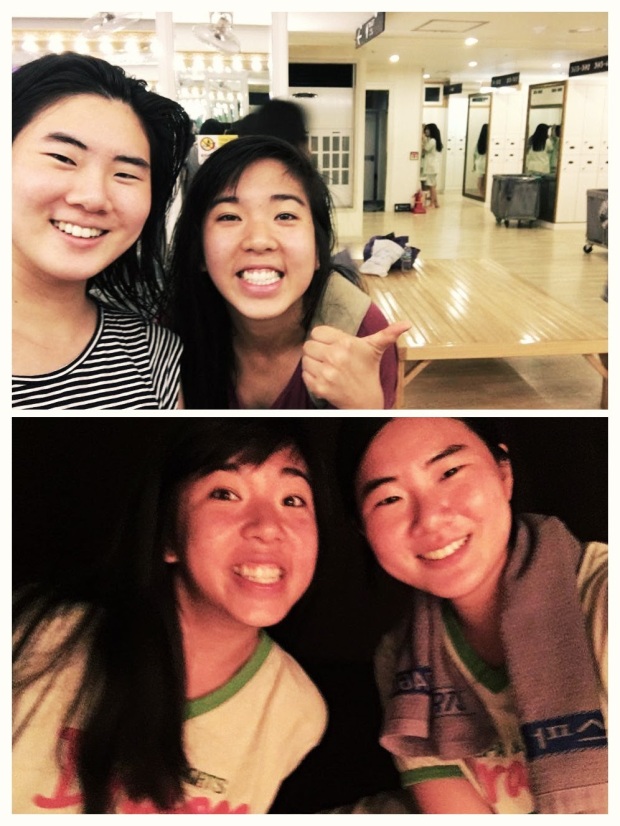
When you sign in, you are given a change of a grungy green set of shirt and shorts. The main area is open space where people lie around and relax on massage chairs but various rooms surround the open area: the oak wood charcoal oven with three temperatures (bottom picture), the pyramid meditative room that smelled like Korean traditional medicine, the pine tree wood fire sweating room, the Hanoki green air room with bacteria-killing air and the ice room. Hyewon and I tried each room for a short while, sometimes sitting in comfortable silence inhaling deeply the thick muggy air and other times conversing quietly.
The second section of the jjimbang is the men and women-only section, where you are required to strip naked. At first, I was real self-conscious but soon enough, as you see everyone sauntering unabashedly around the sauna, you too lose your inhibitions. There were a few hot pools (around 45 degrees C) where you could turn on the jets and sit as it massaged your body, or you could sit in the dry sauna to sweat before dipping into the cold pool to rinse off.
Many Meals Later: working it off in Hangang Park
There were way too many meals in Seoul for me to count them all. Some highlights were:
- Joo Yoo Byul Jang, an exquisite fusion restaurant in Bundang that Hyewon’s sister took us too. Here, I tried makgeoli and liked it for the first time (it was mixed with honey-banana)! The other dishes were hits – secret seasoning pork neck, eggplant in spicy garlic sauce and ricotta cheese sesame tteouk-bbuki.
- Chungjinok, one of the oldest restaurants that serve Hang Judak (hangover soup). Located in Jongno-gu, the place is frequented by locals who want comforting beef bone soup for a perfect end to a day
- Hansik Byeokje, a Korean BBQ restaurant listed by CNN as one of the top restaurants in Seoul. The kalbi meat was grilled to perfection – soft and chewy – served with rice cake and mushrooms on charcoal.
- Sulbing, a famous chain restaurant that serves up patbingsu – shaved ice with various toppings. We ordered the traditional red bean patbingsu with injeolmi over top as well as a more Western coffee one that came with vanilla ice cream and nuts.
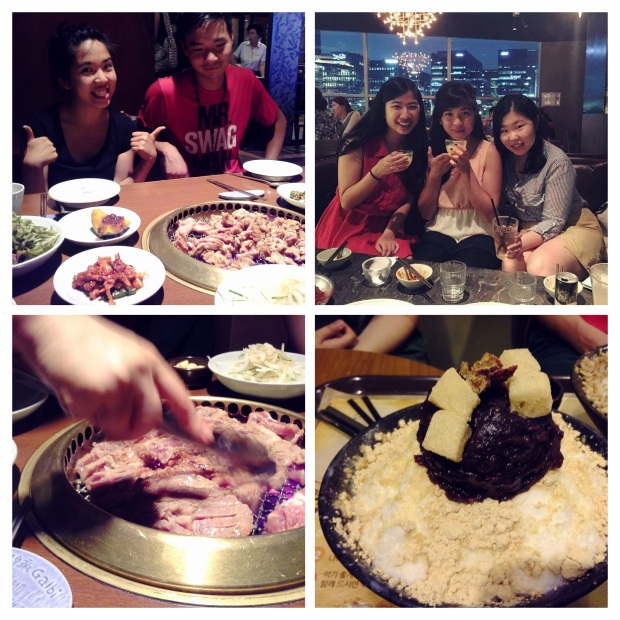
Many filling meals later, however, it was time to work off any extra calories. No better way than to bike down the Hangang River, so we rented bikes off bikeseoul.com that has stations located all over Seoul. We started from Oksu Station Exit 3 and biked west along the paved path, going under bridges and passing grandparents on long river-walks or families picnicking in tents. We crossed the river at Yeuipodo Island and found a little island called Sebitseom on the way back.
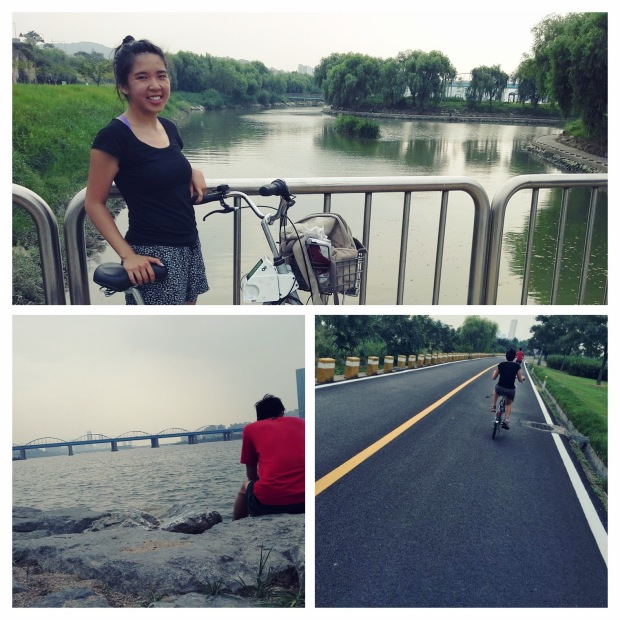
The Hangang River bike ride was the perfect end to my Seoul adventure – and as I took in the beautiful juxtaposition of modern skyline against the peaceful river-sky, I knew I would be coming back soon. This time, I would come armed with a DSLR ready to capture every beautiful moment and I would enroll in One Million Dance Studio classes. Until then, Seoul, you have captured my heart.